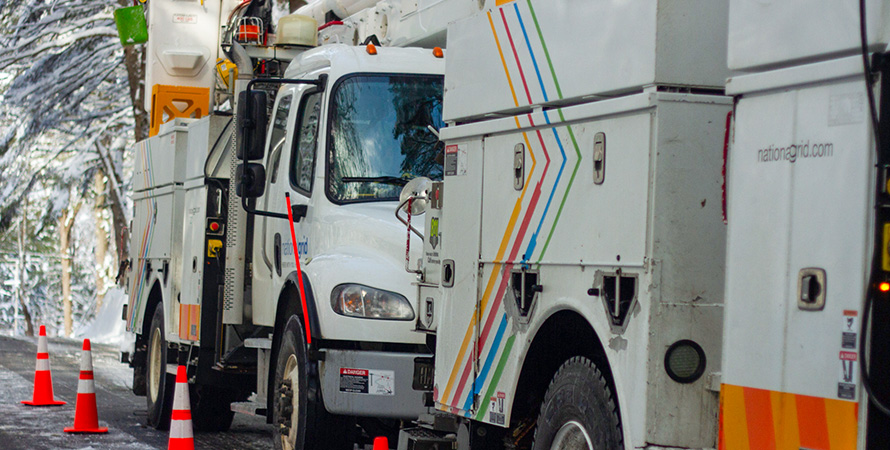National Grid Announces Dry Ice Distribution Sites in Northern New York for Friday
Categories:

National Grid will distribute dry ice and bottled water on Friday to support customers in Northern New York affected by this week’s devastating windstorm. More than 75,000 customers in the region had service interrupted after this week’s storm, which included a wintry mix of rain and snow, and winds in excess of 70 mph.
Dry ice and bottled water distribution is a component of National Grid’s response. The company has deployed more than 2,000 line, service, tree, damage assessment and public safety workers to assess and repair damage to the electric system, and they will work around the clock until the last customers are restored.
Dry Ice and Bottled Water Locations
National Grid will distribute dry ice and bottled water at targeted locations hit hardest by the storm. Customers are asked to bring a cooler or paper grocery bags to transport dry ice to their homes, and company personnel will provide information about the proper handling of dry ice.
All locations open January 12, 2024, from 10 a.m. to 1 p.m.
|
Jefferson County |
St. Lawrence County |
|
Adams Fire Dept. Watertown CitiBus garage |
Hermon Fire Dept. Star Lake Fire Dept. |
What is dry ice?
Dry ice is manufactured by freezing carbon dioxide at very low temperatures until it reaches a solid form. Handle the dry ice very carefully — use gloves, a cloth, etc. to protect your hands while working with the dry ice. It is important to avoid any direct contact with the skin.
When transporting dry ice in your vehicle, remember that carbon dioxide buildup can be hazardous in a closed space. Rolling down windows and ensuring your vehicle’s ventilation system is not set to recirculate are two ways of preventing this buildup in the car. Additionally, always keep small children and pets at a safe distance from dry ice.
Using dry ice safely
Keep dry ice wrapped tightly in newspaper, paper bags, or towels when not in use to extend its shelf life and remain safe. To preserve refrigerated (not frozen) foods, place the dry ice at the very bottom of coolers, refrigerators or other insulated containers. Do NOT put food in direct contact with the dry ice.
To preserve frozen goods, set the dry ice on top of the frozen items. Do NOT allow foods directly the dry ice. Be sure to layer insulating material, such as cardboard or Styrofoam, between the dry ice and perishable items.
Dry ice is not edible; NEVER add it to a beverage or edible item.
When wrapped in an insulating container, small quantities of dry ice have an effective cooling time of roughly 24 hours. Keeping refrigerator and freezer doors closed as much as possible also helps to preserve the food and further extend its cooling life.
When dry ice is unavailable, or if available quantities are only sufficient for preserving your frozen food, look into purchasing regular ice cubes, available at convenience stores, gas stations or other markets. For effective cooling techniques, place bags or containers of ice throughout the refrigerator or cooler. As with the dry ice, avoid direct contact with food.
Stay Informed and Connected
National Grid encourages our customers to monitor local media outlets and stay engaged with our website and social media channels for the latest information about outages and support in their area.
- Customers with active electricity accounts who text ‘REG’ to 64743 can have personalized alerts sent to them via text, email or phone call when we detect an outage on their properties.
- Customers also can text ‘OUT’ to 64743 to report an outage.
- For real-time power outage information, online outage reporting, and in-depth storm safety information, visit National Grid’s Outage Central website. Customers who create an online profile also can sign up for email alerts.
- Customers can read the latest company news, check outage status and report an outage by using the National Grid app.
- Visit our website: www.nationalgridus.com, follow us on X (formerly known as Twitter) and friend us on Facebook.
- Click here for details on the company’s storm preparation and restoration process.
About National Grid
National Grid (NYSE: NGG) is an electricity, natural gas, and clean energy delivery company serving more than 20 million people through our networks in New York and Massachusetts. National Grid is focused on building a smarter, stronger, cleaner energy future — transforming our networks with more reliable and resilient energy solutions to meet state climate goals and reduce greenhouse gas emissions.
Media Contacts
Related News
